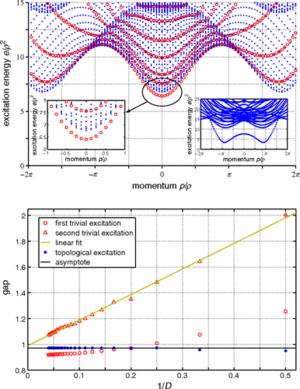Particles, Holes, and Solitons: A Matrix Product State Approach
Category: Scientific HighlightsPublished in Physical Review Letters
ABSTRACT:
We introduce a variational method for calculating dispersion relations of translation invariant (1+1)-dimensional quantum field theories. The method is based on continuous matrix product states and can be implemented efficiently. We study the critical Lieb-Liniger model as a benchmark and excellent agreement with the exact solution is found. Additionally, we observe solitonic signatures of Lieb’s type II excitation. In addition, a nonintegrable model is introduced where a U(1)-symmetry breaking term is added to the Lieb-Liniger Hamiltonian. For this model we find evidence of a nontrivial bound-state excitation in the dispersion relation.
| Figure: | ||
|---|---|---|---|
Draxler D., Haegeman J., Osborne T.J., Stojevic V., Vanderstraeten L., Verstraete F. (2013), Particles, Holes, and Solitons: A Matrix Product State Approach, Phys. Rev. Lett. 111, 020402. DOI:10.1103/PhysRevLett.111.020402
www.sfb-vicom.at/fileadmin/user_upload/proj_comp_mat_lab/0_vicom_publications_pdfs/Vanderstraeten_et_al._-_2014_-_S_Matrix_from_Matrix_Product_States.pdf
Other Recent ViCoM Publications
Sensengasse 8/12
A-1090 Vienna
AUSTRIA
T: +43-1-4277-51401
F: +43-1-4277-9514



